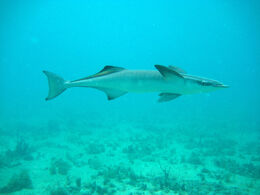
Common remora, (Remora remora)
The remoras /ˈrɛmərəz/, sometimes called suckerfish, are a family (Echeneidae) of ray-finned fish in the order Perciformes. They grow to 7–75 cm (2.8 in–2 ft 5.5 in) long, and their distinctive first dorsal fins take the form of a modified oval, sucker-like organ with slat-like structures that open and close to create suction and take a firm hold against the skin of larger marine animals. By sliding backward, the remora can increase the suction, or it can release itself by swimming forward. Remoras sometimes attach to small boats. They can also attach to other organisms like sharks and turtles of any sort. They swim well on their own, with a sinuous, or curved, motion.
Characteristics[]
Remora front dorsal fins have evolved to enable them to adhere by suction to smooth surfaces and they spend their lives clinging to a host animal such as a whale, turtle, shark or ray. It is probably a Mutualistic arrangement as the remora can move around on the host, removing ectoparasites and loose flakes of skin, while benefiting from the protection provided by the host, and the constant flow of water across its gills. Although it was initially believed that remoras fed off particulate matter from the host's meals, this has been shown a falsehood, in reality their diets are primarily composed of host feces instead.
Habitat[]
Remoras are primarily tropical open-ocean dwellers, occasionally found in temperate or coastal waters if they have attached to large fish that have wandered into these areas. In the mid-Atlantic, spawning usually takes place in June and July; in the Mediterranean, it occurs in August and September. The sucking disc begins to show when the young fish are about 1 cm (0.4 in) long. When the remora reaches about 3 cm (1.2 in), the disc is fully formed and the remora can then attach to other animals. The remora's lower jaw projects beyond the upper, and the animal lacks a swim bladder.
Some remoras associate primarily with specific host species. They are commonly found attached to sharks, manta rays, whales, turtles, and dugongs (hence the common names "sharksucker" and "whalesucker"). Smaller remoras also fasten onto fish such as tuna and swordfish, and some small remoras travel in the mouths or gills of large manta rays, ocean sunfish, swordfish and sailfish.
The relationship between a remora and its host is most often taken to be one of commensalism, specifically phoresy. Though it was originally thought that the host to which it attaches for transport gains nothing from the relationship, research indicates that hosts also benefit, given that remoras feed on parasites (such as copepods) and clean sloughing epidermal tissue as well as ingesting scraps of food, feces, and small nekton and zooplankton. The remora benefits by using the host as transport and protection, and also feeds on materials dropped by the host. Controversy surrounds whether a remora's diet is primarily leftover fragments, or the feces of the host. In some species (Echeneis naucrates and E. neucratoides), consumption of host feces is strongly indicated in gut dissections. For other species, such as those found in a host's mouth, scavenging of leftovers is more likely.
Physiology[]
Research into the physiology of the remora has been of significant benefit to the understanding of ventilation costs in fish.
Remoras, like many other fishes, have two different modes of ventilation. Ram ventilation is the process in which at higher speeds, the remora uses the force of the water moving past it to create movement of fluid in the gills. Alternatively, at lower speeds the remora will use a form of active ventilation, in which the fish actively moves fluid through its gills. In order to use active ventilation, a fish must actively use energy to move the fluid; however, determining this energy cost is normally complicated due to the movement of the fish when using either method. As a result, the remora has proved invaluable in finding this cost difference, (since they will stick to a shark or tube, and hence remain stationary despite the movement or lack thereof of water.) Experimental data from studies on remora found that the associated cost for active ventilation created a 3.7–5.1% increased energy consumption in order to maintain the same quantity of fluid flow the fish obtained by using ram ventilation.
Other research into the remora's physiology came about as a result of studies across multiple taxa, or using the remora as an out-group for certain evolutionary studies. Concerning the latter case, remoras were used as an outgroup when investigating tetrodotoxin resistance in remoras, pufferfish, and related species, finding remoras (specifically Echeneis naucrates) had a resistance of 6.1–5.5×10−8 M.